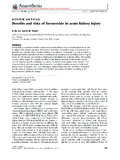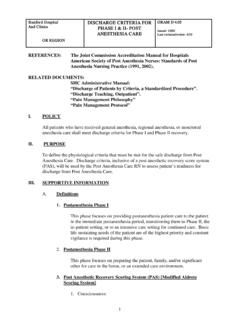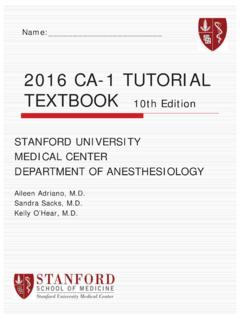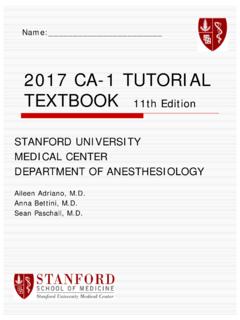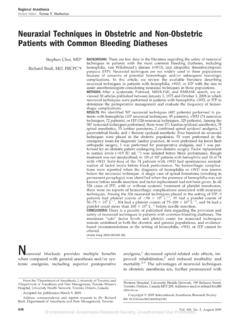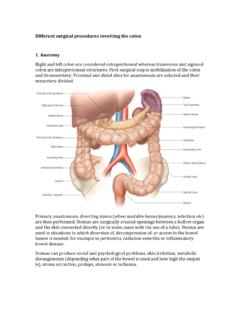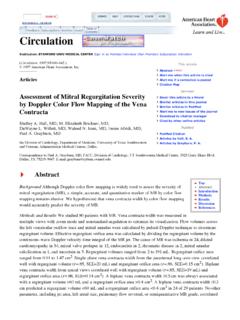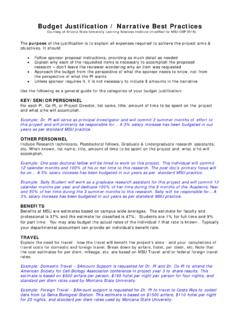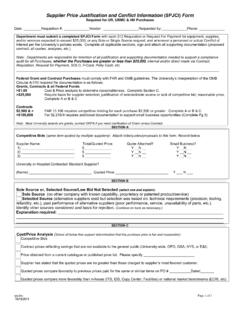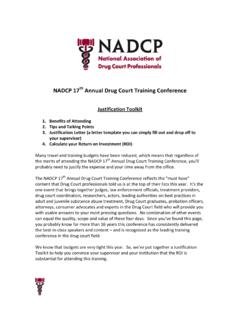Transcription of What does one minute of operating room time cost?
1 EditorialWhat does one minute of operating room time cost ? How much does one minute of OR time cost ? is aquestion often asked in the operating room (OR) suite. Wehear this question during cases that seem to be taking longerthan they should, or when a missing piece of equipmentdelays the next step of the surgery. This question also arisesif there is a last- minute cancellation that leaves the ORunexpectedly idle until another case can be assigned. Thelatter issue is specifically addressed in the nice article by Lauet al.
2 In this issue of theJournal of Clinical Anesthesia. In it,the authors analyze the reasons that cases are cancelled afterthe patient has arrived in the OR[1].The short answer to How much does one minute of ORtime cost ? is, It depends. It depends on many factorsincluding: which country you are in, as resource costs varyfrom country to country; which surgical procedure is beingperformed, as, for example, OR time for a coronary arterybypass graft costs more than for an inguinal hernia repair;whether the answer refers to hospital charges as appearing onthe hospital bill sent to the insurance company or to hospitalcosts related to the actual amount of money that the hospitalspends in providing the surgery.
3 Whether the OR costincludes fixed overhead costs that are constant regardless ofthe number of surgeries perfomed, or if it only accountsfor the variable costs, which vary according to the numberof cases performed; or whether professional fees of thephysician work in the OR are included. The objective of thisarticle is to review these concepts in more Reasons to measure costsA cost is defined as a resource (eg, an ampoule ofpropofol) sacrificed to achieve an objective (ie, patient well-being during surgery)[2].
4 All organizations, includinghospitals, have 4 basic reasons to measure costs: 1) tomake economic decisions for resource allocation, forexample, whether to replace existing anesthesia machines;2) as justification for reimbursement or as a basis forestablishing a fair price, eg, what to charge the patient whoundergoes a kidney transplant; 3) to encourage or discourageuse of services, eg, knowing the cost of a medication helpsthe hospital system to determine whether to make it readilyavailable, or whether specific pharmacy approval is required;or 4) for income and asset measurement for external parties,eg, pharmaceuticals as line-item expense in the end-of-fiscal-year financial adage, If something cannot be measured effectivelyit cannot be managed effectively is true.
5 As a result,improved cost accounting allows for improved managementplanning and control of resources. Importantly, an estimateof what a resource costs depends on whose viewpoint (eg,society, payor, hospital, physician, patient) is taken when acost estimate is cost versus chargeIncentives to reduce costs in the United States result fromthe fee-for-service system. Two important terms, oftenconfused when discussing the business of health care, are: cost = the amount of hospital expenditures for resources(ie, buying supplies) to deliver medical care.
6 However, it isvery difficult for hospitals to know the true cost attributableto delivering care. There are no published formal data ontrue OR costs. Excluding physician costs, OR administratorsmay use a ballpark number such as $15 to $20 per ORminute for a basic surgical procedure, with at least half ofthat figure being fixed overhead costs[3]. The variable costdepends in large part on how OR staff is paid (eg, hourlyor salaried).Charge= the amount of money the doctor or the hospitalbills for medical care. Hospitals do know exactly what thecharges on the patient's hospital bill are, but charge datararely reflect the true cost to the hospital of providing hospital charge master contains thousands of individ-ual items across departments providing patient chargeable item in the hospital must be part of thecharge master for a hospital to bill for Google search identifies some online postings of ORcharges.
7 For example, at one facility a two-hour case of lowcomplexity is billed at $3,520 ($29/min), a figure thatincreases to $9,647 ($80/min) for a high-complexity case[4].This figure does not include the anesthesia charge rangingfrom $185 for the low complexity case to $957 for the most0952-8180/$ see front matter 2010 Elsevier Inc. All rights of Clinical Anesthesia (2010)22, 233 236complex case. A 2005 study of 100 hospitals found thatOR charges averaged $62/min (range: $22 to $133/min)[5].These figures did not include extra resources specific to theprocedure (eg, clip for an intracranial aneurysm) and did notinclude surgeon and anesthesia provider fees.
8 Depending onhow the facility sets its charges, some hospitals may halvethe per- minute OR charge after the first hour of surgery. Sucha calculation is made because the bulk of supplies (custompack opened, implants identified) and bulk of support labor( room set-up, choosing of instruments) occur in the first partof the is important to remember that hospital charges are setover years. Updates to the charge master may not occurfrequently. In fact, with inflationary increases applied tothousands of revenue codes, hospitals may be unable toexplain the rationale for some of their charges.
9 This situationis made apparent in the lay press when patients are shockedat the hospital bill, in particular items such as an aspirin,charged at $10!3. Top-down costingHospitals traditionally have used a top-down costingapproach to determine the cost of a surgical procedure, orthe cost of OR time. The most prevalent top-down costingmethod is the cost -to-charge ratio (Table 1). This top-downmethod estimates costs by computing an overall ratio offacility costs to facility charges as they appear on patients'hospital bills.
10 In the example shown inTable 1, if the sumof all charges for all patients cared for in the OR suiteequals $1,000, and the total expenses incurred to actuallyprovide the care to those patients equal $500, then thecost-to-charge ratio = $500/$1000 = This ratio isapplied to the charges for other items to determine their actual a hospital using a top-down costing approach, if theOR administrator is asked, What is the cost of having apatient in the OR for an additional 15 minutes ? , theadministrator will likely examine the patient charge (as itappears on the patient's hospital bill) for those 15 minutesin the OR and multiply that number by Similarly, ifthe administrator is asked, What is the cost of the using amicroscope during surgery?
